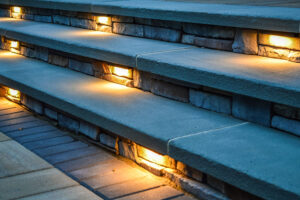
Here are some helpful do’s and don’ts regarding landscape lighting.
When done well, landscape lighting establishes mood as well as a measure of safety and security. However, many people struggle with placing their landscape lights and achieving the desired look. There are certain sets of rules to know first in designing your outdoor landscape. Here are some helpful do’s and don’ts when it comes to landscape lighting.
Do: Focus on Lighting the House First
The most prized and expensive part of your property is your home. That’s why you should spend time focusing on lighting your house using the proper outdoor light fixtures. You will want to illuminate your home and provide safety and security at night. You should position lighting fixtures to highlight the walls of the house as well as architectural features, such as columns or arches.
Do: Add Pathway Lighting for Safety
If you have any pathways in your yard, consider adding path lights to ensure no one trips or tramples on your plants. Solar-powered lights are the easiest solution for path lights because you don’t have to bury any wiring. Creating an illuminated walkway from the street to your home will also boost your property’s curb appeal.
Do: Choose the Right Bulbs
Today, LEDs are the longest-lasting bulbs and the most efficient. However, not all are rated for outdoor use, so check the instructions before you purchase. If you want to control your lighting from one place, consider getting a smart bulb. Smart bulbs can be dimmed, have different tones for a brighter or softer look, and even be set on an automatic schedule.
Don’t: Overdo Your Landscape Light Placement
Less is more when it comes to landscape lighting. What makes it exciting is creating unique ways to incorporate your lighting fixtures without using too much of them. Not only will it cost you more, but it could overwhelm the aesthetic of your outdoor space with too much light coming from your fixtures. Instead, focus only on lighting up essential areas, like pathways or key features, to emphasize safety.
Don’t: Light Pathways and Staircases the Same Way
Pathways are flat surfaces that won’t create shadows. Stairs, alternatively, will show shadows with even the smallest amount of light. For example, placing lights at the top and shining them down a staircase makes it extremely hard to see the bottom stairs and landing. A single light on each step is fine for a narrow staircase, but if the stair is wider, you may need to place multiple lights on each.
Don’t: Put Lights Too Close Together
Landscape lights should draw your eye from one place to another, around the house, or to a focal point. Path lights illuminate certain areas in your yard. By placing them too close to each other, you inhibit their full potential, which is counterproductive to the fixture’s functionality.
Questions? Lehnhoff’s Supply is Here to Help
If you still have more questions about how to use lighting in your landscaping design, the trained professionals at Lehnhoff’s Supply are here to help you.
Find us at 2708 Belair Road, Fallston, MD 21047 and give us a call at 410-510-7646. For tips, tricks, and to see what we have been up to, be sure to follow us on Facebook, X – Twitter, and Pinterest!
We serve but aren’t limited to, the following parts of Maryland: Harford County – Fallston, Forest Hill, Joppa, Edgewood, Bel Air, Churchville, Havre de Grace, Jarrettsville, Street, Aberdeen, Abingdon, and Joppatowne. In Baltimore County: Kingsville, Perry Hall, Overlea, Fullerton, Nottingham, Parkville, Towson, Carney, Loch Raven, Lutherville, Timonium, Hunt Valley, Cockeysville, Sparks, Glyndon, Pikesville, Reisterstown, Ruxton, Parkton, Glen Arm, Baldwin, Monkton, Long Green, White Marsh, Rosedale, Phoenix, and Fork.
This entry was posted on Wednesday, January 24th, 2024 at 2:27 pm. You can follow any responses to this entry through the RSS 2.0 feed. You can leave a response, or trackback from your own site.